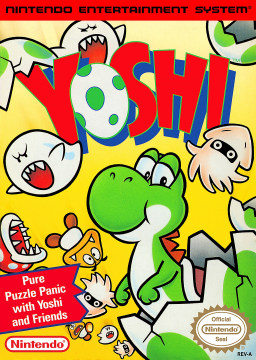General Info
The NTSC version of Yoshi is preferred for speedrunning. See Version Differences for more details.
Speed settings only affect the rate that pieces fall while "down" is not being pressed. Pressing "down" causes pieces to fall at their maximum speed. Selecting a speed setting is a matter of personal preference though most people play on "low".
Swapping stacks should ideally be done before a pair of pieces start falling. Swapping stacks while pieces are falling can lose from 0 to 20 frames depending on how tall the stacks are. Swapping stacks shortly before pieces start falling can also lose time by delaying pieces from falling.
Hatching Yoshi eggs should almost always be avoided. There is an exception to that rule while playing B-Type.
A-Type
The level will advance once 40 pairs of pieces have dropped.. The main strategy for A-Type is to minimize the time that it takes for pieces to fall. That is done by keeping stacks as tall as possible without topping out and while still being able to press down. Maintaining stacks about 5 pieces tall is a reasonable goal to start with. Additionally, stacks should be kept relatively even with each other if possible.
B-Type
B-Type is heavily RNG dependent and the last 2 pieces are often the hardest to clear because of that. The main strategy for B-type is to press down just long enough for the next pair of pieces to appear so that an informed decision can be made before continuing. Often it is preferable to hatch a Yoshi egg if it will clear a level.
Level 1 can be made immediately solvable by starting a game 181 frames, 192 frames, or 210 frames after powering on the console. Those frames correspond to 3.02 seconds, 3.20 seconds, and 3.50 seconds after power on respectively. Manipulating RNG beyond level 1 is very difficult. B-Type has not been optimized to the point that RNG manipulation is strictly necessary. Many Level 1 patterns can be solved at world record pace.
Either "A", "B", "select", or "start" must be pressed to exit the cut-scene between levels. Holding one of those buttons during the cut-scene will exit the cut-scene on the first possible frame. Button mashing is not required.
Version Differences
PAL vs. NTSC
The PAL version attempts to compensate for its reduced frame rate by making pieces fall at a faster rate in some situations.
PAL Drop Rate
- Low Speed: 33 frames per tile
- High Speed: 16 frames per tile
- Hatch Egg: 5 frames per tile
- Press Down: 2 frames per tile
NTSC Drop Rate
- Low Speed: 40 frames per tile
- High Speed: 20 frames per tile
- Hatch Egg: 7 frames per tile
- Press Down: 2 frames per tile
The NTSC version is preferred since most of the time is spent pressing "down".
NTSC-J vs. NTSC-U
The Japanese version does not have an in-game reset function. It is functionally identical to the North American version otherwise.
Random Piece Generation
The game generates a random number between 0 and 255 to determine which piece to spawn next. Pieces have the following chances of being spawned.
- 25.39% (65 / 256): Goomba
- 21.48% (55 / 256): Piranha Plant
- 19.53% (50 / 256): Boo
- 15.63% (40 / 256): Blooper
- 9.77% (25 / 256): Egg Top
- 8.20% (21 / 256): Egg Bottom
Given the information above, the following are the chances of any two pieces spawning together.
- 6.45%: Goomba / Goomba
- 5.46%: Goomba / Piranha Plant
- 4.96%: Goomba / Boo
- 3.97%: Goomba / Blooper
- 2.48%: Goomba / Egg Top
- 2.08%: Goomba / Egg Bottom
- 4.62%: Piranha Plant / Piranha Plant
- 4.20%: Piranha Plant / Boo
- 3.36%: Piranha Plant / Blooper
- 2.10%: Piranha Plant / Egg Top
- 1.76%: Piranha Plant / Egg Bottom
- 3.81%: Boo / Boo
- 3.05%: Boo / Blooper
- 1.91%: Boo / Egg Top
- 1.60%: Boo / Egg Bottom
- 2.44%: Blooper / Blooper
- 1.53%: Blooper / Egg Top
- 1.28%: Blooper / Egg Bottom
- 0.95%: Egg Top / Egg Top
- 0.80%: Egg Top / Egg Bottom
- 0.67%: Egg Bottom / Egg Bottom
Glitches
Egg Glitch
This is a purely visual glitch that occurs when a maximum height stack is topped with an egg bottom and it is moved under another egg bottom on the same frame that the egg bottom starts falling. The two egg bottoms will be destroyed but a glitched egg bottom graphic will remain on the screen. The glitched egg bottom graphic cannot be moved and will remain on screen until another piece moves over it.




